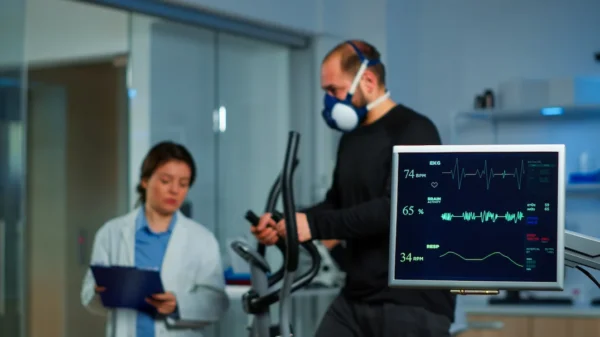A Holter monitor is a portable ECG device that continuously records the heart’s electrical activity over an extended period, most commonly 24 to 48 hours, while you go about your normal daily life. It is used to detect intermittent heart rhythm problems that may not appear during a short, standard ECG performed in the clinic.
Why a Holter Monitor Is Used
Many heart rhythm disturbances come and go. If symptoms such as palpitations, dizziness, shortness of breath, or brief fainting spells do not occur during a routine ECG, they can be missed.
A Holter monitor increases the chance of capturing these episodes by recording every heartbeat throughout the monitoring period.
Doctors commonly request Holter monitoring to:
- Evaluate unexplained palpitations or irregular heartbeats
- Investigate dizziness or near-fainting episodes
- Assess heart rate control in atrial fibrillation
- Detect pauses, slow heart rates, or fast rhythms
- Monitor the effect of medications on heart rhythm
How a Holter Monitor Works
Small adhesive electrodes are placed on the chest and connected by wires to a lightweight recording device, usually worn on a belt or shoulder strap. The monitor continuously records the heart’s electrical signals while you are awake, asleep, resting, and active.
Unlike some other monitors, a Holter device records continuously, not only when you press a button. This provides a complete picture of heart rhythm over the monitoring period.
What to Expect While Wearing a Holter Monitor
Wearing a Holter monitor is painless and generally well tolerated. You are encouraged to continue your usual daily activities so the recording reflects real-life conditions.
You will usually be asked to keep a simple activity and symptom diary, noting the time of any symptoms such as palpitations, chest discomfort, or dizziness. This allows doctors to match symptoms with the heart rhythm at that moment.
Bathing, showering, or swimming is usually avoided during the monitoring period unless you are given a waterproof device.
What the Holter Monitor Can Detect
A Holter monitor can identify:
- Irregular heart rhythms such as atrial fibrillation or flutter
- Episodes of rapid heart rate (tachycardia)
- Slow heart rates or pauses (bradycardia)
- Premature beats from the atria or ventricles
- Rhythm changes related to activity or sleep
It also helps assess how often these events occur and whether they are associated with symptoms.
What the Holter Monitor Cannot Always Show
If symptoms occur less frequently than every few days, they may not appear during a 24–48 hour recording. In such cases, longer-term monitoring methods may be more appropriate.
A normal Holter result does not always rule out a rhythm problem; it simply means no abnormal rhythm was captured during the recording period.
After the Holter Monitor Is Removed
Once monitoring is complete, the device is returned and the data are analyzed. A detailed report is generated, showing heart rhythm patterns throughout the day and night.
Your doctor will review the results with you and explain whether any abnormalities were found and whether further testing or treatment is needed.
Is the Holter Monitor Safe?
Yes. Holter monitoring is completely safe and non-invasive. It does not deliver electricity to the body and does not involve radiation.
In Summary
A Holter monitor is a simple and effective way to continuously record heart rhythm over one or two days in real-life conditions. It is especially useful for evaluating intermittent symptoms and guiding further diagnosis and treatment. When symptoms are frequent but unpredictable, Holter monitoring is often the most practical next step after a standard ECG.
Reference: Holter Monitor






